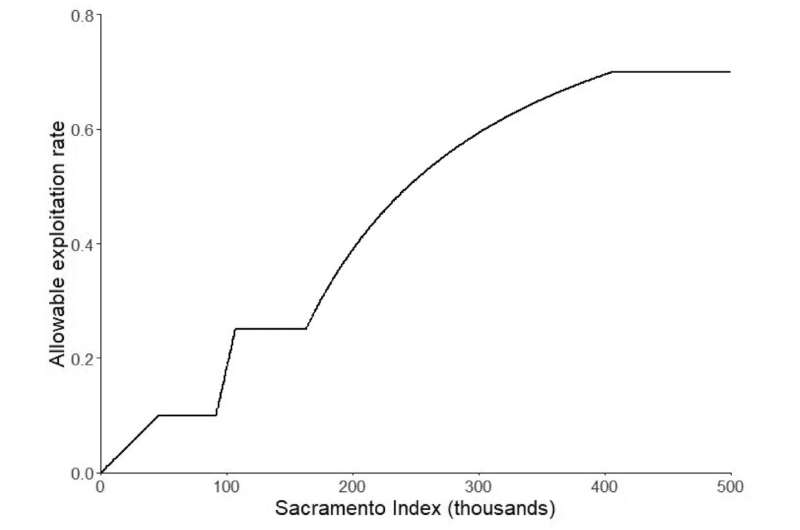This article has been reviewed according to Science X's editorial process and policies. Editors have highlighted the following attributes while ensuring the content's credibility:
fact-checked
peer-reviewed publication
trusted source
proofread
Shrinking age distribution of spawning salmon raises climate resilience concerns

By returning to spawn in the Sacramento River at different ages, Chinook salmon lessen the potential impact of a bad year and increase the stability of their population in the face of climate variability, according to a new study by scientists at UC Santa Cruz and NOAA Fisheries.
Unfortunately, spawning Chinook salmon are increasingly younger and concentrated within fewer age groups, with the oldest age classes of spawners rarely seen in recent years. The new study, published in the Canadian Journal of Fisheries and Aquatic Sciences, suggests changes in hatchery practices and fishery management could help restore the age structure of the salmon population and make it more resilient to climate change.
The researchers focused on Sacramento River fall-run Chinook salmon, which contribute heavily to the salmon fisheries of California and southern Oregon. This population is particularly susceptible to the effects of increasingly severe drought conditions driven by climate change.
"As we get more variable climate conditions, with greater extremes of rainfall and drought, we are going to see more 'boom-and-bust' population dynamics unless we start to restore the age structure of the population, which can spread out the effects of good and bad years across time," said senior author Eric Palkovacs, professor of ecology and evolutionary biology and director of the Fisheries Collaborative Program at UC Santa Cruz.
If most of the salmon return to spawn at the same age, one bad year could be devastating for the overall population. Spreading the risk over multiple years is an example of what ecologists call the "portfolio effect," like a financial portfolio that spreads risk over multiple investments.
First author Paul Carvalho, a postdoctoral fellow with the Fisheries Collaborative Program, explained that juvenile salmon are especially vulnerable to the effects of drought as they migrate to the ocean from freshwater rivers and streams.
"We focused on the impacts of drought on the survival of juvenile salmon, but drought conditions can also increase mortality of returning adult salmon as they migrate upstream to spawn," he said.
Carvalho developed a life cycle model of the Sacramento River fall-run Chinook salmon population to simulate the effects of different drought scenarios and other variables on the population. The model was grounded in data from field studies, such as research by NOAA Fisheries scientists that quantified the relationship between river flows and survival rates of juvenile salmon.
The model allowed the researchers to assess the effects of different mechanisms that can affect the age structure of the population. A century ago, most of the spawning salmon returning to the Sacramento River watershed were four years old, and some were as old as six years. Today, however, six-year-old fish are rarely observed and most of the spawners are three years old.
"Historically, you would have seen huge salmon coming back at older ages, but over the past century they've gotten smaller and younger," Palkovacs said. "The dominant age class is now 3 years, and there are very few even at age 5, so there's been a big shift in the age structure."
Decreased size and age at maturity is a classic pattern of fisheries-induced evolution. A high mortality rate for older fish selects for fish that mature at earlier ages, because a fish that dies before it can spawn doesn't pass on its genes. But fishing pressure is not the only factor driving changes in the age structure of the salmon population. Hatchery practices can also inadvertently select for earlier maturation.
"It's pretty clear that current hatchery practices are resulting in very homogeneous populations returning at age three," Palkovacs said. "Rather than producing a uniform product, it would be better to increase the diversity of the age structure by selecting older, larger fish and making sure you get as many of them into the spawning population as possible."
Carvalho noted that improving the age structure of the population by selecting for fish that spend more years at sea (delayed maturation) would be most effective in combination with reduced harvest rates.
"Because the fish remain in the ocean longer, they are exposed to the fishery and other causes of mortality for a longer period, so that reduces the number returning to spawn if you don't reduce fishing pressure on those older age classes," he said.
Overall, the results show that maintaining or increasing the age structure through reduced mortality and delayed maturation improves the stability of the salmon population, buffering against the adverse effects of drought and making the population more resilient in an increasingly variable climate.
"Regardless of the mechanism, whether it's reduced mortality or delayed maturation that's driving it, increasing the diversity of the age structure will increase the stability of the population," Carvalho said.
More information: Paul G. Carvalho et al, Role of maturation and mortality in portfolio effects and climate resilience, Canadian Journal of Fisheries and Aquatic Sciences (2023). DOI: 10.1139/cjfas-2022-0171
Journal information: Canadian Journal of Fisheries and Aquatic Sciences
Provided by University of California - Santa Cruz



















